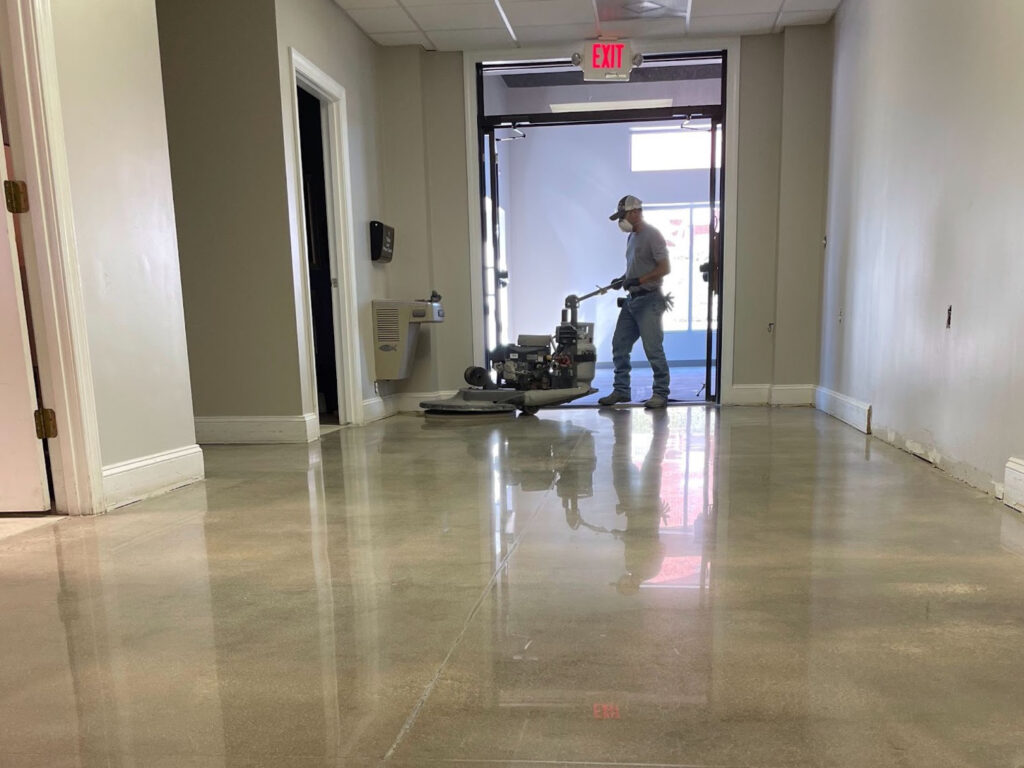Polished concrete is a popular option for residential, commercial, and industrial spaces. This affordable flooring option is beautiful, long-lasting, and easy to clean and maintain. While polished concrete floors are not maintenance-free, they generally are easier to care for than other types of decorative concrete floors since they do not require waxing or sealing. Over time, polished concrete may become dull and lose the reflectivity it had when originally polished. Site-specific factors such as the amount and types of traffic combined with the amount and type of dirt and contaminants will determine the exact maintenance plan needed. Not only do polished concrete floors require basic maintenance by the property owner but periodic maintenance by a professional polished concrete floor specialist is recommended.
The maintenance of polished concrete floors is no different than any other hard surface floor. Soils and stains on the surface must be addressed, correct cleaning chemicals must be used, and personnel must be properly trained to maintain the floor to its original look. Polished concrete floors can generally be cleaned with clean water and a clean mop. They do not require abrasive cleaners or chemicals. If you feel the need to use a cleaner, neutral-PH cleaners should be chosen to avoid potentially deteriorating the finish.

General Maintenance Recommendations:
Daily
Remove Surface Dirt
The main aspect of routine maintenance for polished concrete is the daily removal of dirt and debris. If left untreated the dirt can abrade the surface of the floors, causing them to lose their shine. This can be accomplished with a soft, dry dust mop, an untreated microfiber dust mop, or a vacuum with a soft-bristled attachment. The use of dirty pads or rough surfaces can damage the polished concrete surface of the floor.
Clean liquid spills and stains immediately.
Certain types of spills can result in stains to the polished concrete surface if allowed to remain on the floor for an extended time, especially if the spill contains any liquid that is acidic, caustic, or citric. These types of liquids can cause surface etching.
Use entry/walk-off mats
It’s best to place floor mats at all entrance points. With an entry mat in place, rainwater, which could be acidic (acid rain), and the amount of dirt that gets tracked onto polished concrete floors is greatly reduced. Entry mats must be maintained and kept clean to reduce dirt accumulation.
Weekly
Polished concrete floors can generally be cleaned with clean water and a clean mop. A neutral-PH cleaner could be used in high-traffic areas to clean spills and prevent stains. Cleaners that are acidic or too alkaline may cause surface damage that could dull the shine of the polished concrete floors. A commercial concrete floor scrubber that is equipped with a clean, non-abrasive pad could also be used to help remove dirt buildup and are great for getting spills cleaned-up quickly. The less time a spill is on the floor the less chance of it leaving a stain. A dry soft towel or microfiber cloth could also be used to remove excess water. This will help prevent streaks from appearing but also protect against the growth of mold caused by dampness underneath the surface. Do not use traditional floor waxes; they are incompatible with the finishing treatments used for polished concrete and unnecessary.
Monthly/Quarterly
Buffing the polished concrete floors, with a high-speed burnisher fitted with a diamond grit pad will remove scratches and surface stains, and will achieve that high-gloss shine. High-traffic areas may need burnishing more often to maintain that shine. Remember to always clean before burnishing. If there is dirt on the floor, burnishing will grind it in.

Annually
To maintain polished concrete flooring’s ability to resist staining and bring back their original beauty, professional concrete flooring specialists would start the restoration process by using a water-based floor stripping agent to clean away dirt and debris. A stain protector/guard product would then be applied to safeguard the finish and prevent dirt and other pollutants from infiltrating the surface.
Depending on the amount of traffic, weather, and overall wear and tear, a professional concrete flooring specialist would be able to repair surface-level damage by filling divots and cracks to the floor surface before moving forward with applying a new coat of guard.
Conclusion
Polished concrete is an easy-to-maintain and attractive floor type for many commercial applications and is becoming more popular across industries. Learning how to maintain a polished concrete floor is something that takes a little time and patience. A scheduled maintenance plan will ensure your polished concrete floors maintain the same top-quality, finished appearance for many years to come.